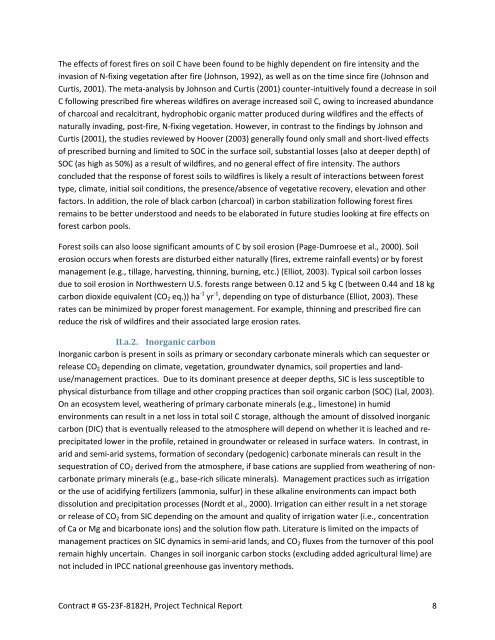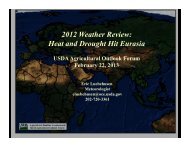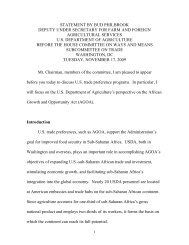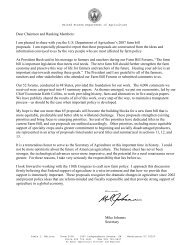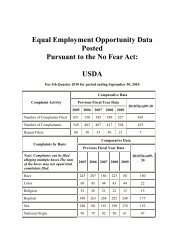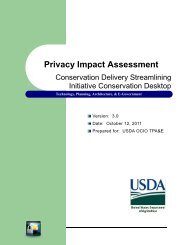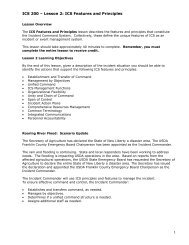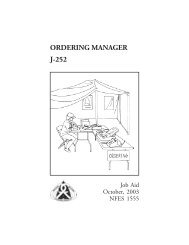Greenhouse Gas Emissions from U.S. Agriculture and Forestry: A ...
Greenhouse Gas Emissions from U.S. Agriculture and Forestry: A ...
Greenhouse Gas Emissions from U.S. Agriculture and Forestry: A ...
Create successful ePaper yourself
Turn your PDF publications into a flip-book with our unique Google optimized e-Paper software.
The effects of forest fires on soil C have been found to be highly dependent on fire intensity <strong>and</strong> the<br />
invasion of N‐fixing vegetation after fire (Johnson, 1992), as well as on the time since fire (Johnson <strong>and</strong><br />
Curtis, 2001). The meta‐analysis by Johnson <strong>and</strong> Curtis (2001) counter‐intuitively found a decrease in soil<br />
C following prescribed fire whereas wildfires on average increased soil C, owing to increased abundance<br />
of charcoal <strong>and</strong> recalcitrant, hydrophobic organic matter produced during wildfires <strong>and</strong> the effects of<br />
naturally invading, post‐fire, N‐fixing vegetation. However, in contrast to the findings by Johnson <strong>and</strong><br />
Curtis (2001), the studies reviewed by Hoover (2003) generally found only small <strong>and</strong> short‐lived effects<br />
of prescribed burning <strong>and</strong> limited to SOC in the surface soil, substantial losses (also at deeper depth) of<br />
SOC (as high as 50%) as a result of wildfires, <strong>and</strong> no general effect of fire intensity. The authors<br />
concluded that the response of forest soils to wildfires is likely a result of interactions between forest<br />
type, climate, initial soil conditions, the presence/absence of vegetative recovery, elevation <strong>and</strong> other<br />
factors. In addition, the role of black carbon (charcoal) in carbon stabilization following forest fires<br />
remains to be better understood <strong>and</strong> needs to be elaborated in future studies looking at fire effects on<br />
forest carbon pools.<br />
Forest soils can also loose significant amounts of C by soil erosion (Page‐Dumroese et al., 2000). Soil<br />
erosion occurs when forests are disturbed either naturally (fires, extreme rainfall events) or by forest<br />
management (e.g., tillage, harvesting, thinning, burning, etc.) (Elliot, 2003). Typical soil carbon losses<br />
due to soil erosion in Northwestern U.S. forests range between 0.12 <strong>and</strong> 5 kg C (between 0.44 <strong>and</strong> 18 kg<br />
carbon dioxide equivalent (CO2 eq.)) ha ‐1 yr ‐1 , depending on type of disturbance (Elliot, 2003). These<br />
rates can be minimized by proper forest management. For example, thinning <strong>and</strong> prescribed fire can<br />
reduce the risk of wildfires <strong>and</strong> their associated large erosion rates.<br />
II.a.2. Inorganic carbon<br />
Inorganic carbon is present in soils as primary or secondary carbonate minerals which can sequester or<br />
release CO2 depending on climate, vegetation, groundwater dynamics, soil properties <strong>and</strong> l<strong>and</strong>‐<br />
use/management practices. Due to its dominant presence at deeper depths, SIC is less susceptible to<br />
physical disturbance <strong>from</strong> tillage <strong>and</strong> other cropping practices than soil organic carbon (SOC) (Lal, 2003).<br />
On an ecosystem level, weathering of primary carbonate minerals (e.g., limestone) in humid<br />
environments can result in a net loss in total soil C storage, although the amount of dissolved inorganic<br />
carbon (DIC) that is eventually released to the atmosphere will depend on whether it is leached <strong>and</strong> re‐<br />
precipitated lower in the profile, retained in groundwater or released in surface waters. In contrast, in<br />
arid <strong>and</strong> semi‐arid systems, formation of secondary (pedogenic) carbonate minerals can result in the<br />
sequestration of CO2 derived <strong>from</strong> the atmosphere, if base cations are supplied <strong>from</strong> weathering of non‐<br />
carbonate primary minerals (e.g., base‐rich silicate minerals). Management practices such as irrigation<br />
or the use of acidifying fertilizers (ammonia, sulfur) in these alkaline environments can impact both<br />
dissolution <strong>and</strong> precipitation processes (Nordt et al., 2000). Irrigation can either result in a net storage<br />
or release of CO2 <strong>from</strong> SIC depending on the amount <strong>and</strong> quality of irrigation water (i.e., concentration<br />
of Ca or Mg <strong>and</strong> bicarbonate ions) <strong>and</strong> the solution flow path. Literature is limited on the impacts of<br />
management practices on SIC dynamics in semi‐arid l<strong>and</strong>s, <strong>and</strong> CO2 fluxes <strong>from</strong> the turnover of this pool<br />
remain highly uncertain. Changes in soil inorganic carbon stocks (excluding added agricultural lime) are<br />
not included in IPCC national greenhouse gas inventory methods.<br />
Contract # GS‐23F‐8182H, Project Technical Report 8


